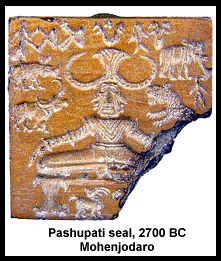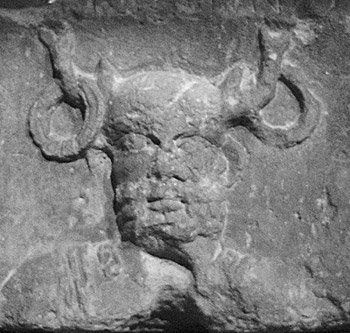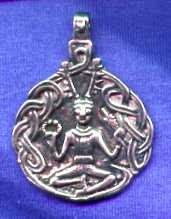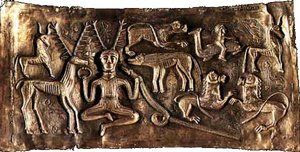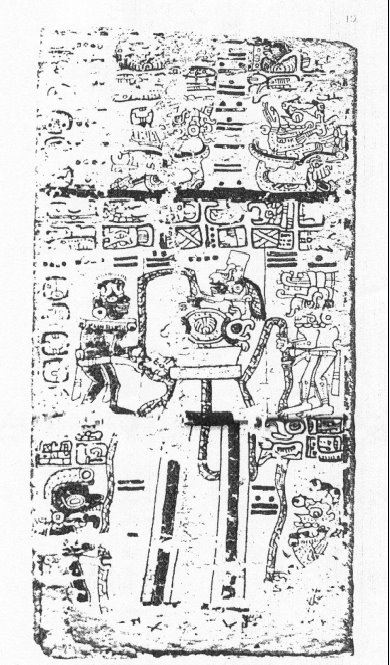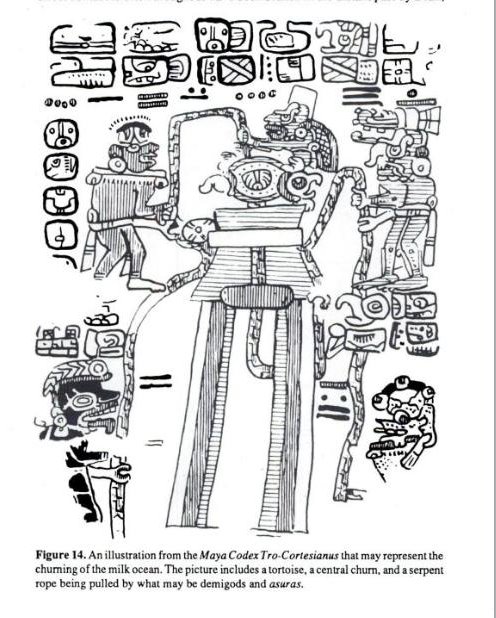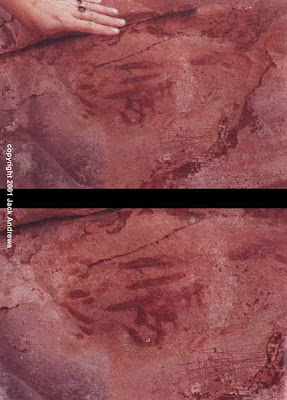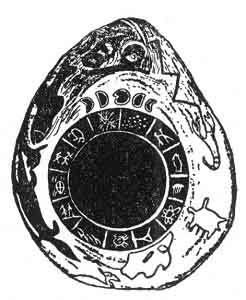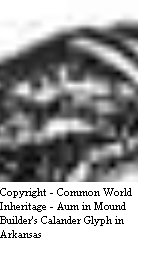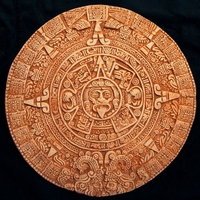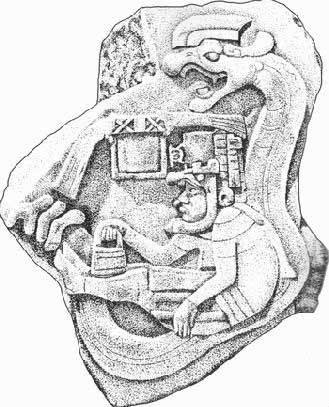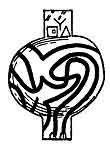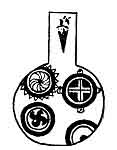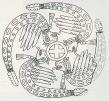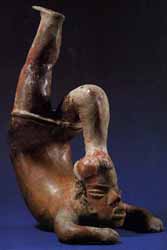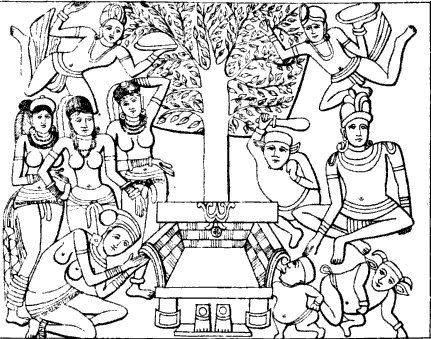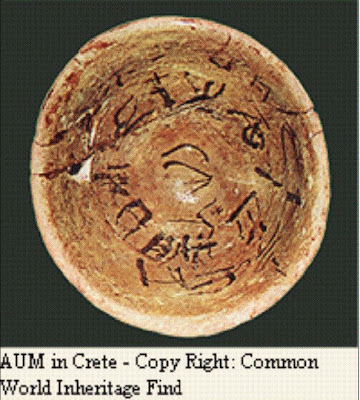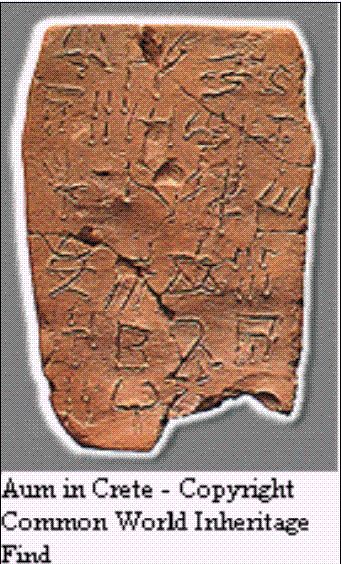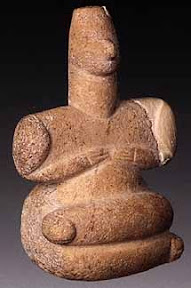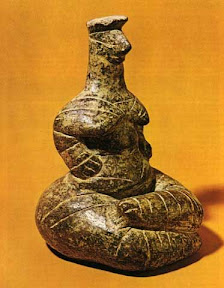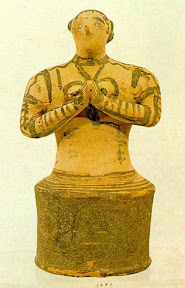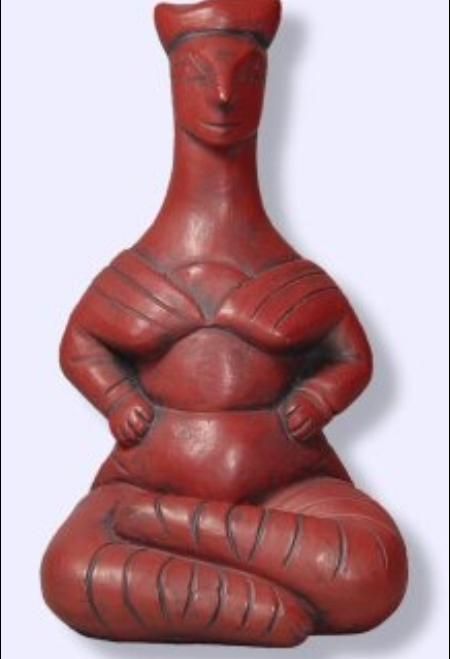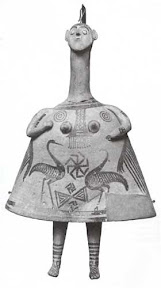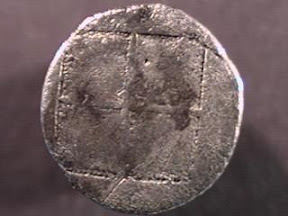by Ricardo Palleres
What if Europe was really in darkness in comparison to the Far East and India that Columbus set sail to find? What if the popular idea that the Tibetans and the American Indians have much in common in terms of their spiritual culture is largely a result of another historical scenario? What if Hindus and Hopis, Advaitins and Aztecs, Tibetan monks and Mayans were part of one world culture -- a spiritual one?
It very well may come to pass in the near future that those concerned with truth will wrestle primarily with history rather than science. The obvious reason for this is that, in the words of Dr. Wilfred Cantwell Smith, author of Theology and the World's Religious History, "Humanity is more important than things. The truth about humanity is of a higher order than the truth about things."1
History tells an intriguing tale, one that ultimately may provide the greatest support for a spiritual worldview. But history has also been distorted. An example of this is the "common knowledge" that Columbus discovered America. Some say he didn't, nor were any other Europeans the first to touch America's shores. There is good reason to reexamine the history of the world and the Americas in particular. An unbiased look into the development of our planet's civilizations may help to bring about a change in values, a shift from material values to spiritual ones.
What if Europe was really in darkness in comparison to the Far East and India that Columbus set sail to find? What if the popular idea that the Tibetans and the American Indians have much in common in terms of their spiritual culture is largely a result of another historical scenario? What if Hindus and Hopis, Advaitins and Aztecs, Tibetan monks and Mayans were part of one world culture -- a spiritual one? Perhaps the development of Western civilization and the Protestant ethic, which many of the West are now coming to abhor, have gotten in the way of the spiritual development of humanity. Perhaps many technological developments, while making physical contact with other cultures more possible, have distanced us from one another in a deeper sense. Another historical scenario: The spiritually sophisticated Asians were the first to set foot on Western shores, and Asia, not Europe, was the seat of culture. The central focus of that culture was genuine spiritual development, not the mere shadow of the same in the form of the politically-motivated Pauline Christianity and later the Protestant ethic, which licensed humankind's exploitation of nature.
This theory is found in the Vedic literature of India. The ancient Puranas (literally, histories) and the Mahabharata make mention of the Americas as lands rich with gold and silver. Argentina, which means 'related to silver,' is thought to have been named after Arjuna (of silver hue), one of the heroes of that great epic. India's Puranic histories are, however, questionable to the rationalist. In the minds of the empiricists, they are more akin to myths. Yet myths have meaning, as the late Joseph Campbell has reminded us. The Puranas downplay in particular the mere recording of mundane events. The Puranic view is that even if its histories are only myths (which is not necessarily the case), the lessons to be learned from them are infinitely more valuable than what can be learned from recording the coming and going of humanity. In their view, only those human events that serve to promote transcendental knowledge are worth recording. Although empiricists are justified in dismissing them from their viewpoint, the so-called myths and their followers are also justified in dismissing the empiricist's insistence that empirical evidence is final.
Granted, India has shown some lacking in her ability to record her story. But that is due to her preoccupation with the transcendent, the suprahistorical, and not to any ineptitude on her part. According to Kana Mitra in her article "Theologizing Through History?" "We [Hindus] tend to forget about history, and the de-emphasis of nama-rupa -- name and form [due to transcendent preoccupation] -- is one of the reasons for not putting down a name or date in many of our writings. Consequently present-day historians have a difficult time in determining the date and authorship of various works."2
Fortunately, for dealing with the "I'll only believe it if I can see it" mentality of the empiricist, there is considerable hard evidence and academic support for the Vedic theory that most people are unaware of. Unbiased consideration of this remarkable evidence may move modern-day rationalists to give serious thought to the more realistic spiritual outlook of "Only if you believe it can you see it." After all, reality is a living thing and it may reserve the right not to show itself but to those to whom it so chooses. Otherwise, why are we in illusion, or in search of reality? If it is something we can attain by our own prowess, how did we get here (in doubt) in the first place?
The meeting (1519) of Hernan Cortes and the Aztec emperor Montezuma II is depicted in this 17th century Spanish painting. (British Embassy, Mexico City). Unfortunately, the American Indians did not survive their cultural exchange with Europe. The Europeans, through book burning and bayonet, successfully "converted" them leaving very little trace of their noble civilization.
Many historians have scrutinized historical evidence to find more insight into the marvelous cultures that populated the American continent before Christopher Columbus was born. Their thirst for research was based on the assumption that the great Mayan, Aztec, and Incan civilizations could not have appeared all of a sudden in the Western world. Rather, they must have received strong influence from ancient Eastern cultures, mainly from India.
Alexander von Humbolt (1769-1859), an eminent European scholar and anthropologist, was one of the first to postulate the Asiatic origin of the Indian civilizations of the Americas. His and other scholars' views formed the basis for the "diffusionist" argument, which was opposed by the "isolationist" viewpoint. Diffusionists believe that the world's civilizations are a result of social contact (civilized man meets uncivilized man). Isolationists believe that civilizations cropped up all over the earth without physical contact with one another.
The Aztec Calendar is known as the Aztec Chakra to Hindu Astronomers. (National Museum of Anthropology, Mexico.)
"The doctrine of the world's ages (Hindu Yugas) was imported into Pre-Columbian America... The Mexican sequence is identical with the Hindus... The essential fact remains that they were derived from a common source... It would be ridiculous to assert that such a strange doctrine was of spontaneous origin in different parts of old and new worlds." — Mackenzie, Myths of Pre-Columbian America.
It is readily accepted that some twenty thousand years ago primitive Asians crossed the Bering Strait into North America and gradually moved south all the way to Tierra del Fuego, Argentina. Diffusionists maintained that after this occurred civilized Asiatic people distributed themselves via the Pacific, thereby bringing civilization to the Americas. Isolationists insisted that after the nomadic tribes crossed the Bering Strait, a homogeneous race of "Indians of the Americas" was formed, and the American tribespeople then went about reinventing all culture, duplicating in two thousand years what originally took about six millenniums in the Old World.
Henry Charlton Bastian, author of The Evolution of Life (1907), presented the concept of physicochemical evolution, which gave strength to the isolationists. His theory advocated that the development of civilized man was a result of "a psychic unity of mankind," rather than social contact. Bastian's theory of elementargedanke influenced many anthropologists, and today, although the theory is not accepted, it is tacitly acknowledged as far as the conformities between America and Old World civilizations are concerned.3
This pseudo-evolutionist theory leaves much to be desired, and its unspoken acceptance casts doubt on the credibility of the anthropologists. After all, doesn't it tax our credulity when we are asked to believe that a whole series of complicated techniques like casting by the lost wax method, the alloying of copper and tin, the coloring of gold by chemical processes, weaving, and tie-dyeing and batik were by some miracle invented twice, once in the Old World and again from scratch in the Americas? What mysterious psychological law would have caused Asians and Americans to both use the umbrella as a sign of royalty, to invent the same games, imagine similar cosmologies, and attribute the same colors to the different directions?
No archeologist today would attribute to prehistoric Europeans the independent invention of bronze casting, iron work, the wheel, weaving, pottery, writing, and so many other cultural elements that were derived from the Middle East. Similarly, the industrial developments in Britain were introduced from elsewhere within the European continent, not developed independently. What then would cause one to insist that what was not possible for the Europeans (duplicating culture independently) was possible for the American Indians? Especially when at the same time we are taught that the Europeans were of superior stock!
It was in 1949 that these opposing views met head-on at the Congress of the Americanists held in New York, which was sponsored by the American Museum of Natural History. At that time, the diffusionists presented an overwhelming mass of Asiatic-Pacific-American parallels. Nonetheless, much of the diffusionists' evidence continues to be ignored, and the isolationist view is more widely accepted. The reason for this may be more than empirical evidence or lack of the same. Indeed, it may be the faulty nature of the empirical approach, which depends on one's imperfect senses and causes one to dismiss facts that do not conform with the prevailing worldview.
The Aryan civilization of India is a logical choice for the beginning of the diffusion of our planet's civilization. American historian Will Durant, in his book Our Oriental Heritage, described India as the most ancient civilization on earth, and he offered many examples of Indian culture throughout the world. He demonstrated that as early as the ninth century b.c.e. Indians were exploring the sea routes, reaching out and extending their cultural influence to Mesapotamia, Arabia, and Egypt.
"Europe, after Guttenburg's invention of the printing press, wasted no time in announcing the discovery of the New World. It was at this time that European historians began to present to the rest of the world that their land was the center of culture and civilization."
Although modern-day historians and anthropologists might prefer to accept Egypt or Babylon as the most ancient civilization, due to various archeological findings, their theories are by no means conclusive. The popular theory in the academic community that the Aryans were an Indo-European stock, who spoke an unknown pre-Sanskrit language and only later invaded India subsequently occupying her, is also considerably lacking in supportive evidence. Indeed, there is very little evidence whatsoever for the postulated Aryan invasion of India. But perhaps it is easier for modern people to accept ancient Egypt and Babylon, whose ancient civilizations have no living representation and thereby do not pose any challenge to the status quo.
But India is alive and kicking. Prominent traces of ancient Vedic civilization can still be found today not only in India but outside her borders as well. The life science of ayurveda, yoga and meditation, and Sanskrit texts translated into modern languages are all prominent examples. If we recognize ancient India as a civilized spiritual giant, we will have to reckon with her modern-day representations. It is altogether possible that the Vedic theory, if thoroughly researched, poses a threat to many of the concepts of modern civilization and the current worldview, as can be seen by the fact that the Vedic literature and spiritual ideology loomed as the greatest threat to the British in their imperialistic conquest of India.
The Aryans' footprints are found throughout neighboring Southeast Asia. They were skilled navigators and pioneers of many cultural developments. According to several sources, these Aryans ruled in Java, Bali, Sumatra, Borneo, Philippines, Cambodia, Vietnam, Annan, Burma, and Thailand until the fourteenth century. Even today, the kings of Thailand bear the title Rama after the Indian Ramraja (the perfect kingdom said to have been governed by the incarnation of Godhead Ramachandra). And the story of Ramayana is depicted on the palace walls in Bangkok.
Cambodia, the ancient Kamboja, boasts the largest temple complex in the world, named Ankor, from the Sanskrit language meaning "the capital city." It was built in the ninth century c.e. in honor of the Hindu god Vishnu. The complex extends over an area more than twice the size of Manhattan and took thirty-seven years to complete. Its physical and spiritual grandeur is found elsewhere only in ancient Greece, Egypt, and among the Mayan and Aztec civilizations. Cambodia's principle river is today called Me Kong, which some scholars say is derived from India's Ma Ganga (Mother Ganges).
Vietnam, once called Champa, figures prominently as a stepping-stone in the story of India's cultural expansion to the Americas. Furthermore, the Hindu state of Java was founded by the king of Kalinga (Orissa) in the first century c.e. Java is said to be the ancient Yava-Dveepa mentioned in the Ramayana and other Sanskrit texts. The Indonesian national flag flies the symbol of Garuda, the bird carrier of Vishnu. Garuda is also the national symbol of that country.
In 1949, two scholars, Gordon Ekholm and Chaman Lal, systematically compared the Mayan, Aztec, Incan, and North American Indian civilizations with the Hindu-oriented countries of Southeast Asia and with India herself. According to them, the emigrant cultures of India took with them India's system of time measurement, local gods, and customs. Ekholm and Lal found signs of Aryan civilization throughout the Americas in art (lotus flowers with knotted stems and half-dragon/half-fish motifs found commonly in paintings and carvings), architecture, calendars, astronomy, religious symbols, and even games such as our Parcheesi and Mexican patolli, which have their origins in India's pachisi.
Both the Hindus and the Americans used similar items in their worship rituals. They both maintained the concept of four yuga cycles, or cosmological seasons, extending over thousands of years, and conceived of twelve constellations with reference to the Sun as indicated by the Incan sun calendar. Royal insignias, systems of government, and practice of religious dance and temple worship all showed remarkable similarities, pointing strongly to the idea that the Americas were strongly influenced by the Aryans.
The temples of India (pict. 1-2) are built according to the ancient Vedic architectural science. There are striking similarities between Mayan temples and those in India. Pict. 3-4: Two Mayan temples from Palenque, Mexico and Central America.
Another scholar, Ramon Mena, author of Mexican Archeology, called the Nahuatl, Zapoteca, and Mayan languages "of Hindu origin." He went on to say, "A deep mystery enfolds the tribes that inhabited the state of Chiapas in the district named Palenque. . . . Their writing, and the anthropological type, as well as their personal adornments . . . their system and style of construction clearly indicate the remotest antiquity. . . . [they] all speak of India and the Orient."4 Still another scholar, Ambassador Poindexter, in his two-volume 1930s treatise The Arya-Incas, called the Mayan civilization "unquestionably Hindu."
The Aztec culture in particular shows a striking resemblance to that of India. Aztecs divided their society into four divisions of both labor and spiritual status, as did the Hindus. In India, this system of government was known as varnashrama, or the division of society based on body types and mental dispositions resulting from past karma. As in Indian civilization, the Aztecs maintained a God-centered government in which people were employed in accordance with their natural karmic tendencies. The results of the labor of all the priests, administrators, mercantilists, and laborers were for the glorification of Godhead, who in turn was thought to provide for humankind.
Aztec boys were sent to school at the age of five, at which time they were put under the care of a priest and trained in various duties of temple life. The Aztec system of education bears a striking resemblance to the Indian system of gurukula, in which boys were sent to the care of a guru for spiritual and practical education. The Mayans and Incas had a similar approach to education, which was mainly a training for priestly service. Fanny Bandelier's translation of Sahagun's History of Ancient Mexico describes that the intellectually inclined boys were trained as "ministers to the idols."
Girls were educated in the domestic arts at home and did not mingle with young boys. Even as late as the 1930s, there was no courtship between Mexican Indian girls and boys, as is still the case in village life in India today. From conception to education, marriage, death, cremation, and even the observance of the sati rite, there are overwhelming parallels between Indian society and the Americas. Further evidence of cultural ties between the East and West is found in the statues of American gods who show a striking resemblance to the Hindu deities of Hanuman, Shiva, Indra, Vishnu and others. Such statues have been found throughout the Americas, and many of them can be seen today in museums in Central America.
The Mexican Indians and the Incas of Peru were primarily vegetarians. They were of high moral character and hospitable and generous as a habit. They practiced astrology, and mental telepathy was common among them. It was perhaps their peace-loving disposition that, like the Hindus, allowed them to be ruled by Europeans. Unfortunately, the American Indians did not survive their cultural exchange with Europe. The Europeans, through book burning and bayonet, successfully "converted" them, leaving very little trace of their noble civilization.
And what about Europe? When merchants sailing from India brought delicious spices, aromatic perfumes, incense, fine silk, precious stones set in delicate and rare jewelry, complex craftsmanship of ivory, and many other goods never seen before by Europeans, the riches and mystique of that land captivated them. The stories told by many navigators about that land of wonder, where the palaces were built of varieties of marble rather than rush stone, decorated with beautiful sculptures and wooden inlay, made the Queen of Spain so covetous that she provided Christopher Columbus with all necessities for his famous journey. Columbus had heard of India's riches through the writings of Marco Polo. Polo had written that India "was the richest and noblest country of the world."5
Europe, after Guttenburg's invention of the printing press, wasted no time in announcing the discovery of the New World. It was at this time that European historians began to present to the rest of the world that their land was the center of culture and civilization. In comparison to Indian society, however, the Europeans were rather crude. The ominous age of the Inquisition, with its persecution and fanaticism, the use of mechanical devices to insure the "chastity" of its women, the exploitation of the serfs, and self-destructive habits, such as indiscriminate eating and alcoholism within the higher classes, are all evidence of this. The original Palace of Versailles in Paris, although certainly a unique architectural creation requiring genius, was built without a single bathroom. Louis XIV and his court are said to have evacuated behind curtains, cleaning themselves with the same. The king was in the habit of substituting soap with Indian perfume and waited until his thirty-fifth birthday before he took his first complete bath.
When Europe was still uncivilized, Indian culture, as well as American culture, was highly advanced. When Europeans were still cave dwellers and nomads wandering from place to place subsisting through hunting, some American peoples were plowing fields and baking bread and dressing in cotton, the seeds for which came from India. The subtlety of Indian society, both eastern and western, marks its superiority to Europe. It was a subtlety of spiritual outlook that Europeans failed to appreciate.
The Dresden Codex, one of the few Mayan hieroglyphic manuscripts that survived the book-burnings by Spanish invaders, documents astronomical calculations of the planed Venus. Large numbers of codices were compiled by the Mayan priests to record religious rites and astronomical facts. (Sachsische Landesbibliothek, Dresden, East Germany.)
The industrial revolution of Europe was prompted by India's cotton, which competed with European wool. Later when the popularity of cotton products imported from India increased, the Europeans began to manufacture cotton in mills. Thus it was even an Indian resource that prompted Europe's claim to fame -- the beginning of modern technology.
It is altogether possible that the Vedic theory, if thoroughly researched, poses a threat to many of the concepts of modern civilization and the current worldview.
Several ancient cultures of the Americas were more spiritually attuned than the Europeans. They also lived with great regard for nature. Many people today are searching out the spirituality of the Americas, a spirituality that was lacking in Europe and is now lacking throughout the world. The Christ's teachings were most certainly tainted with misunderstanding of that great savior's message of love. And he too is said to have been influenced by India's spirituality. His appearance in the world for that matter is mentioned in India's Bavishya Purana long before the virgin birth took place.
The theory that India, Mother India, is the earthly source of spirituality can be to some extent supported by the fact that India is still today the most religious country in the world, with a theology that dates back to antiquity. The idea that she is the source of civilization as well, although supporting evidence is available, will ultimately require that modern man reevaluate what constitutes civilization before it gains wider acceptance.
Notes
1. Wilfred Cantwell Smith,"Theology of the World's Religious History," Toward a Universal Theology of Religion, Orbis Books, Maryknoll, N.Y. (1987) p.69.
2. Kana Mitra, "Theologizing Through History?" Toward a Universal Theology of Religion, Orbis Books, Maryknoll, N.Y. (1987), p.82.
3. Dr. Robert Heine Geldern, "Challenge to Isolationists," Hindu America, Chaman Lal, Zodiac Press, New Delhi, (1940) Introduction p.vii.
4. Ibid., p. 14.
5. Marco Polo, The Travels of Marco Polo (The Venitian), revised from Marsden's translation and edited with introduction by Manuel Komroff, Livright Pub, (1956) p.201.
Further References
William Mccgillivray, The Travells and Research of Alexander von Humbolt, Harper Bros. N.Y. (1872).
Henry Charles Bastian, The Evolution of Life. E.P. Dutton & Co. N.Y. (1907).
Gordon Ekholm, Excavations At Sinaloa, American Museum of Natural History, N.Y. (1942).
Gordon Ekholm, Excavations at Lampico and Panuco in the Hausteca, American Museum of Natural History N.Y. (1944).
Reprinted from Clarion Call Magazine with permission.



